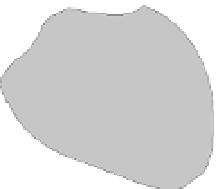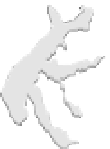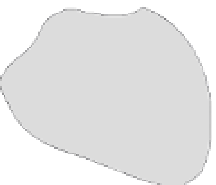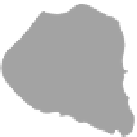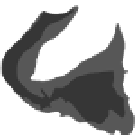Biomedical Engineering Reference
In-Depth Information
of the
class of immunoglobulins, which have antibody activity. The primary function of
fibrinogen is to work with thrombocytes in the formation of a blood clot—a process also
aided by one of the most abundant of the lesser proteins, prothrombin.
Of the remaining 2 percent or so (by weight) of plasma, just under half consists of miner-
als (inorganic ash), trace elements, and electrolytes, mostly the cations sodium, potassium,
calcium, and magnesium and the anions chlorine, bicarbonate, phosphate, and sulfate—the
latter three helping as buffers to maintain the fluid at a slightly alkaline pH between 7.35
and 7.45 (average 7.4). What is left, about 1,087 mg materials per deciliter of plasma, includes
(1) mainly three major types of fat—cholesterol (in a free and esterified form), phospholi-
pids (a major ingredient of cell membranes), and triglyceride—with lesser amounts of the
fat-soluble vitamins (A, D, E, and K), free fatty acids, and other lipids, and (2) “extractives”
(0.25 percent by weight), of which about two-thirds include glucose and other forms of carbo-
hydrate, the remainder consisting of the water-soluble vitamins (B-complex and C), certain
enzymes, nonnitrogenous and nitrogenous waste products of metabolism (including urea,
creatine, and creatinine), and many smaller amounts of other biochemical constituents—the
list seeming virtuously endless. It is easy to understand why blood is often referred to as
the “river of life.” This river is made to flow through the vascular piping network by two
central pumping stations arranged in series: the left and right sides of the human heart.
The heart (Figure 3.18), the pumping station that moves blood through the blood vessels,
consists of two pumps: the right side and the left side. Each side has one chamber (the
atrium) that receives blood and another chamber (the ventricle) that pumps the blood
away from the heart. The right side moves deoxygenated blood that is loaded with carbon
dioxide from the body to the lungs, and the left side receives oxygenated blood that has had
most of its carbon dioxide removed from the lungs and pumps it to the body. The vessels
that lead to and from the lungs make up the pulmonary circulation, and those that lead
to and from the rest of the tissues in the body make up the systemic circulation (Figure 3.19).
g
SUPERIOR
VENA CAVA
AORTIC ARCH
SUPERIOR VENA CAVA
PULMONARY
ARTERY
LEFT
ATRIUM
RIGHT
ATRIUM
LEFT
ATRIUM
RIGHT
ATRIUM
MITRAL
VALVE
TRICUSPID
VALVE
PULMONARY
SEMILUNAR
VALVE
RIGHT
VENTRICLE
RIGHT
VENTRICLE
LEFT
VENTRICLE
SEPTUM
LEFT
VENTRICLE
(a)
(b)
FIGURE 3.18
(a) The outside of the heart as seen from its anterior side. (b) The same view after the exterior
surface of the heart has been removed. The four interior chambers—right and left atria and right and left
ventricles—as well as several valves are visible.
